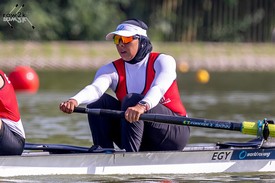Charlotte Hollings, Calm Waters Rowing

Drills can be helpful, but too often we do them without really knowing their purpose. We do them because we've gotten in the habit, because our former coach did the drill, or maybe it's just one we like. If you're going to do a drill, figure out why you do it, and what specifically is it supposed to help. Then when you transition from the drill to regular rowing, determine how that drill affected what you were trying to work on. Did it help? If not, maybe it's not worth continuing.
Some drills are almost universally detrimental, we believe. Square blade rowing is one of those. How many times have you seen a crew rowing square blade with blades whacking on the water and the boat lurching from side to side? How can that be accomplishing anything? I think the professed goal of square blade rowing is to teach rowers to push down and get a clean extraction of the blade from the water. In reality, it teaches people to cut off the finish by getting the blade completely out of the water by the end of the drive.
We would much prefer to see rowers hold on to the drive, to keep the blade at least partially buried as long as the arms are coming towards the body; i.e., as long as you're on the drive. You can hold on to the drive for the duration and instead just allow the top half of the blade to come out of the water as you reach the finish.

Just before you feather, you cut the pressure and make the feather the beginning of the recovery, not the end of the drive.
Another drill we find to be counterproductive is pause at arms away. We never want you to be in this position. The speed you can gain at the release comes not from the motion of the hands going out of bow, but from the body. As the body swings to the stern, the bow moves in the other direction. And by getting the body out of bow immediately (not waiting for the hands to go first), it's much easier to increase the stroke rate without rushing up the slide.
Arms and body out of bow simultaneously whereas pausing at arms away encourages and teaches arms then body as two separate motions. More and more elite athletes are rowing down the course at 38 to 42 strokes per minute - there isn't time at that rating to go arms then body; instead everything rolls out of bow together.

The other difficulty with arms away is it tends to cause stiff arms at the catch. We'd like to see loose arms so that you can catch with the arms and not with the body. Loose arms also help to keep the boat more stable. If arms are locked, a set disruption will knock the body off kilter but if the arms are loose, the arms can absorb the imbalance, keeping the body directly over the keel.

Don't do drills blindly. Make sure they have a purpose and that they're achieving that purpose. If a particular drill doesn't work for you, find another one that does.

If you enjoy and rely on row2k, we need your help to be able to keep doing all this. Though row2k sometimes looks like a big, outside-funded operation, it mainly runs on enthusiasm and grit. Help us keep it coming, thank you! Learn more.
Comments | Log in to comment |
- Bont Rowing
- Calm Waters Rowing
- Concept 2
- Craftsbury Sculling
- The Crew Classic
- CrewLAB
- Croker
- Durham Boat Co.
- Empacher
- Faster Masters
- Filippi
- Fluidesign
- h2row.net
- HUDSON
- Live2Row Studios
- Nielsen-Kellerman
- Oak Ridge RA
- Peinert Boat Works
- Pocock Racing Shells
- Race1 USA
- RowKraft
- Rubini Jewelers
- Vespoli USA
- WinTech Racing
- Bont Rowing
- Calm Waters Rowing
- Concept 2
- Craftsbury Sculling
- The Crew Classic
- CrewLAB
- Croker
- Durham Boat Co.
- Empacher
- Faster Masters
- Filippi
- Fluidesign
- h2row.net
- HUDSON
- Live2Row Studios
- Nielsen-Kellerman
- Oak Ridge RA
- Peinert Boat Works
- Pocock Racing Shells
- Race1 USA
- RowKraft
- Rubini Jewelers
- Vespoli USA
- WinTech Racing


















09/02/2018 11:32:32 PM
08/31/2018 4:48:58 AM
I've taken recently to calling for novice crews to do one square-blade stroke; cox warns "One stroke square blades" and then at the catch "this one". Once the crew has confidence in doing one, cox moves up to two, and so on.
08/29/2018 9:36:55 AM
08/28/2018 2:19:40 PM
Any conventional drill, as well as unconventional ones, have positives and negatives. The first paragraph of this article as well as the concluding two sentences, describe well how purpose is needed behind drills. Coaches should look for the negative side effects, but as long as they have their vision of what a good rowing stroke is and are seeking to get crews to that point - all can be used, including square blade rowing and pausing at arms away.
08/28/2018 7:19:42 PM